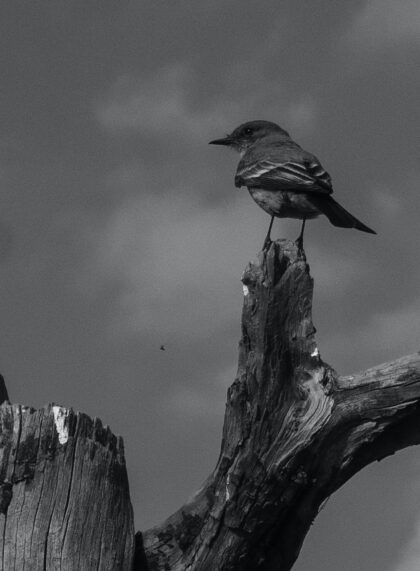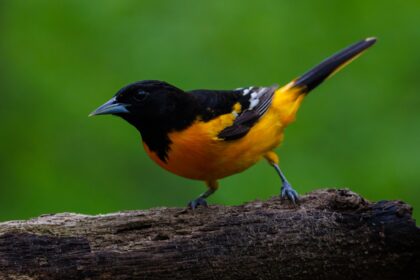
The Pythagorean theorem. The Archimedes’ screw. Hubble’s Law. Numerous ideas and inventions carry human names as a way to honor their discovers or inventors. Plants and animals can be anthropomorphized in this way too: Grévy’s zebra or Hirst’s panic grass, for example. Well, just as with libraries and university buildings and any number of other eponymous entities, sometimes we reconsider on whom we wish to bestow naming honors. And so plans are forming to change the common names in English of roughly 80 bird species from North America.
The American Ornithological Society has decided that any common name of a bird which contains a person’s name will be changed. The scientific names, the ones in Latin or Latinish neologisms, will remain the same. New names have not been selected, but the intention is apparently to focus on descriptive names, rather than swapping personae non gratae for les gens du jour. Perhaps most notable is the Audubon’s shearwater, one of many namesakes of nature illustrator John James Audubon. Some of the societies for birding and conservation named for him are also rethinking that association due to the fact that his family owned slaves and he opposed abolition.
Although the recent wave of names changes in the US has focused primarily on slave owners, prominent figures of the Confederacy, and others whose wealth or prominence are linked with exploitation of others, renaming to reflect current priorities and values has a long history. There’s even a song about it. American towns with German names rebranded themselves temporarily or permanently when we were at war with Germany. Diseases get renamed to avoid unwanted associations or just to clarify their nature, such as last year when monkeypox became mpox. And does anyone remember that brief moment when we were supposed to call them freedom fries because of France’s opposition to the war in Iraq?
Renaming is a recurring Biblical theme as well. Off the top of my head, Abraham & Sarah, Peter & Paul, and Daniel, Hananiah, Mishael, & Azariah come to mind. (Incidentally, why do we know the latter three by their Babylonian names Shadrach, Meshach, and Abednego but almost no one refers to Daniel as Belteshazzar?) I imagine there are other examples I’m forgetting. And of course there are numerous names and titles for God, which reflect the expanding understanding of God’s nature over time.
Naming also figures prominently in Genesis 2, where Adam names all the animals and birds. There is an additional purpose to highlight the lack of a peer for Adam among the creatures, but given the significance of names throughout the Bible I think it’s reasonable to treat naming as a meaningful responsibility in its own right. And while that responsibility isn’t explicitly passed to the rest of humanity, out of necessity we have to assume it anyway. So why shouldn’t we give the task serious consideration?

Back to the birds, while I don’t really have a bird dog in the fight, one thing I appreciate about the plan is how it is comprehensive. Rather than pick and choose who is no longer deserving of an eponymous avian, all the names associated with a person will get replaced. If they do go through with descriptive names, then the update can be justified on cognitive grounds independent of social concerns. Given names are hard to remember because they don’t correlate with anything. The same name can belong to a variety of people who have nothing else in common, either physically or psychologically. Our brains seem to do best when different neural connections reinforce each other, but names rarely get to benefit from that reinforcement. So descriptive names stand a better chance of being easier to learn and remember, at least for those who encounter them fresh. The transition may be more challenging for those who have used the current names for decades.
On the flip side, I am most sympathetic to the concerns about losing references to the history of birding and ornithology. But ultimately, I think there are other ways to preserve history. I don’t think John James Audubon is in any danger of being completely forgotten any time soon. And that line of thinking presumes that names preserve history well in the first place. There’s Stigler’s law of eponymy which says that no discovery is named after the actual discoverer (including Stigler’s law and the three examples which open this blog post). And then there’s the reasonable possibility that other folks made comparable contributions but just never got picked for naming honors. Finally, one detail I did not see in the news coverage I read is the fact that these birds likely were first discovered and named by Indigenous people. If they don’t get naming honors (although perhaps they do in their own languages), why should anyone else?
I’m less persuaded by the concern expressed by Jerry Coyne that the effort to change names could be spent on other inclusivity efforts. For one, I don’t think anyone is suggesting that we couldn’t or shouldn’t also do what Coyne proposes. For another, as the article notes earlier, the idea to rename the birds grew out of a wider movement for inclusivity in birding. That movement started with an incident in Central Park involving false accusations against birder Christian Cooper. (Cooper wrote and edited X-Men comics in the 90s and is currently a science communicator; he’s clearly my kind of people.) And while the rename itself may be somewhat performative, such acts can generate positive attention in a way that ongoing programs may not; just announcing the intention to change names got coverage from major national and international news outlets.
In that regard, renaming birds isn’t as much ornithology as it is applied sociology, along with an application of cognitive psychology and neuroscience to create more memorable names. But we rarely call such activities by those names. Perhaps we might be able to have more fruitful conversations about them if we did.
Are there any renaming efforts going on now or recently in your discipline? How are such efforts framed? Do you think they have been worthwhile?
Andy has worn many hats in his life. He knows this is a dreadfully clichéd notion, but since it is also literally true he uses it anyway. Among his current metaphorical hats: husband of one wife, father of two teenagers, reader of science fiction and science fact, enthusiast of contemporary symphonic music, and chief science officer. Previous metaphorical hats include: comp bio postdoc, molecular biology grad student, InterVarsity chapter president (that one came with a literal hat), music store clerk, house painter, and mosquito trapper. Among his more unique literal hats: British bobby, captain’s hats (of varying levels of authenticity) of several specific vessels, a deerstalker from 221B Baker St, and a railroad engineer’s cap. His monthly Science in Review is drawn from his weekly Science Corner posts — Wednesdays, 8am (Eastern) on the Emerging Scholars Network Blog. His book Faith across the Multiverse is available from Hendrickson.

Leave a Reply